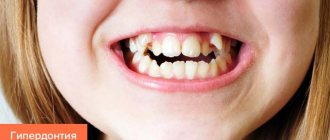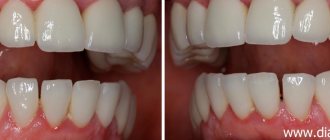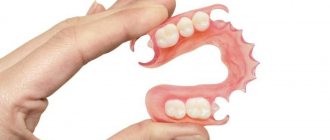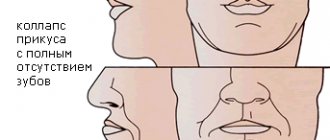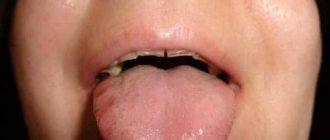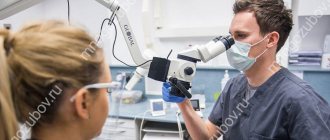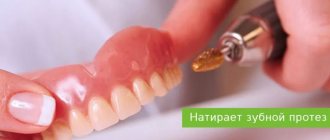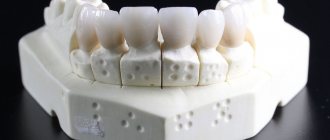The overdenture received this name due to the nature of the device that covers all the teeth in a row. The principle of its operation remains the same as that of other prosthetic structures. Fixation occurs on 3-4 supports, which can be the remaining molars, or this function can be performed by implants screwed into the jaw.
How do covering dentures differ from removable dentures?
It’s easy to get confused in the concepts here, so let’s clarify that both types are removable. At least, that is what is commonly believed.
But in the classical view, coverings always have a strong support - teeth or implants. And traditional removable ones, especially with complete edentia, are fixed only on the gums. Although it is worth noting that in fact, even ordinary removable dentures have recently begun to be called overlays - this is argued by the fact that such structures also cover. Just not teeth or implants, but gums.
DENTAL PROSTHESIS ON 4 IMPLANTS - from RUB 140,000.
The price includes all procedures for installing Osstem implants (South Korea), including anesthesia and diagnostics.
Hurry up to sign up for a free consultation and fix your prices.
Call now or request a call
Opening hours: 24 hours a day - seven days a week
Installation options
The decision to use prosthetics is made after consultation and examination. The choice of the optimal method of carrying out the procedure depends on the current state of the prosthetic bed: the pliability of the mucous membrane, the degree of atrophy of the alveolar processes, the presence of bone protrusions, the shape and condition of single teeth/roots (quality of filling, absence/presence of convergence, response to tapping):
- on a natural frame. When installing a covering prosthesis, rational use of the remaining living elements should be a priority. To preserve them, the following are practiced: amputation (removal of one branch of a multi-root unit) and separation (dissection of the tooth into segments in the inflammatory area). This allows the roots to be used as the basis for restoration. An additional plus: the vertical transmission of pressure during chewing reduces the load on the mucous membrane, without causing a feeling of discomfort and shortening the adaptation period;
- on implants. For jaw prosthetics without teeth, their use is considered the best and most accessible method, due to the high percentage of clinical success, aesthetic effect and improved quality of life and chewing. Planning of orthopedic/surgical treatment protocols using this technique should take place after a thorough X-ray diagnosis in order to minimize the risks of postoperative complications and rejection of artificial frames.
Covering dentures with fixation on the gums
This is the most famous and simplest type - the prosthesis is indicated for complete edentia (complete absence of teeth) and is attached only to the gums due to the “suction cup” effect. Such removable orthopedic structures take up a lot of space in the oral cavity - due to the massive artificial gum on the lower jaw and the palatal overlap on the upper jaw. Otherwise, they simply won't be able to resist.
Among the advantages are the lowest cost, almost complete absence of contraindications. The disadvantages are the following:
- very low comfort: nausea, gum chafing, blocked taste buds,
- poor fixation: displacement and falling out of the mouth, so there is a need to use a special “glue”, which does not always help,
- need for adjustments due to bone atrophy.
Bone atrophy deserves special mention. Areas of the jaw where there are no longer roots remain “idle.” And the bone, which does not receive chewing pressure, begins to atrophy (reduce in size in width and height). As a result, the gingival level decreases, and after a few months the removable “jaw” becomes uncomfortable - you will have to visit an orthopedist and have the structure repositioned.
Options include plate acrylic, Acry-free, nylon, polyurethane, Quattro Ti. You can read more about each variety by following the links.
Overdentures fixed to dental implants
Complete removable dental dentures require reliable and comfortable fixation, which is impossible if the structure is simply “sucked” to the gums. To do this, implants are installed on the dentition. The optimal quantity is 4 pieces for the upper jaw (here the bone is less dense) and 3-4 for the lower jaw. Some dentists install only 2 implants, but this number is not enough, because... the prosthesis does not hold very securely on them, and the implants are overloaded.
Implantologists recommend not placing all implants only in the anterior part of the jaw, if possible, but also using the lateral areas. This is optimal both from the point of view of distribution of the chewing load and the preservation of bone in the lateral areas.
PROSTHETICS WITH 6 OSSTEM IMPLANTS FROM RUB 200,000.
Complex implantation Osstem (South Korea) with delayed loading after 4-6 months.
Call now or request a call
A removable overdenture can be fixed to implants in different ways - on a spherical mount, on an equatorial type mount (Locator), on a beam. The covering orthopedic structure on implants is quite stable and it is not necessary to remove it every day. Therefore, dentists classify it not just as removable, but as conditionally removable prosthetics. Next, we will look in more detail at fixation methods.
"Push-button" fastening
On ball-shaped abutments
Ball mount is considered the simplest and most inexpensive option. In this case, in order to fix the overlay prosthesis, you need to place abutments on the implants (these are a kind of “adapters”) with a ball-shaped top. Special recesses are made in the prosthetic structure - matrices equipped with metal holders and silicone rings - when the patient installs the prosthesis, the matrix snaps onto the ball.
On equatorial type abutments
Equator-type or Locator abutments are also snapped into a silicone matrix, which is placed on the inside of the prosthetic base. However, the tops of the abutments are already presented in the form of cylinders with a seal on top, rather than balls. Therefore, their wear period, and, accordingly, their service life is longer.
As a rule, removable dentures on spherical and equatorial abutments are considered temporary options when the patient currently does not have the opportunity to undergo full implantation with fixed prosthetics.
Fixation on beam
A metal beam is the optimal way to fix a removable prosthetic structure on implants, because The chewing load is best distributed along the beam, which will then go to the implants and the jaw bone. The beam can be made by soldering or casting, but it is best milled using CAD/CAM systems (it is the most accurate). It is attached on top of the implants, uniting them like a bridge. And then a partial or full covering prosthesis is snapped onto the beam - there are special fasteners at its base, exactly in the shape of the beam.
Separately, it is worth highlighting non-removable dentures on implants - which the patient cannot remove on his own. Because they are fixed to the implants with small screws. But from the dentist’s point of view, this type will be conditionally removable, because The doctor himself can safely and quickly unscrew the screws and remove the structure - for example, for cleaning or repair. And then install it back. Such prosthetics are used with the very popular All-on-4 implantation technique.
How many implants are needed?
The optimal number of implants is four per jaw . Allows you to correctly distribute chewing loads, avoid atrophy of bone tissue under the prosthesis, and increase the stability and efficiency of the entire structure.
We do not recommend a smaller number - in this case, implants are installed only in the frontal zone, the length of the beam is small. Accordingly, the prosthesis will be unstable in the lateral sections; constant balancing will lead to overload of the implants.
Sometimes six implants may be required for the upper jaw - the bone is softer and looser, so more supports are installed so that the load is distributed evenly.
Covering dentures with fixation on your teeth
When several natural teeth are preserved, a removable overdenture is fixed on their crowns or roots. After examining the oral cavity, the dentist may suggest one of the following mounting options:
- on clasps or hooks that cover the supporting teeth on the sides without covering them completely. For example, an “immediate butterfly” for 1-2 teeth, a clasp with clasps, as well as those already mentioned above (for fixation on the gums) can also be equipped with clasps,
- on spherical attachments: attachments are locking fasteners and are installed on the tooth root. The upper part of the attachment is usually presented in the form of a miniature ball onto which the inner part of the covering prosthesis is fixed. The second part of the lock is located in the prosthetic base. Such fastening, for example, is found in a sandwich prosthesis,
- on telescopic crowns: the fastening is similar to the previous type, but here an artificial one is installed on the root or remains of your own crown - and a slightly larger crown is installed in the prosthesis. The two elements fit very tightly onto each other, so the structure can not be removed for several weeks. But in production, this type requires a very highly qualified dentist so that the crowns fit perfectly together.
Read on the topic: how telescopic crowns increase the comfort of life after prosthetics.
Design features
Consists of artificial gums and teeth. The main retaining components are locking fasteners located at the base of the removable segment and on the surface of the non-removable section of the combined structure. In complex clinical situations, magnetic clamps with additional mechanical devices are used - telescopic crowns, push-button/rail fasteners. Made from metal, acrylic, nylon. The process of prosthetics includes two stages: preparation of the preserved fragments/organs, during which the doctor fixes frame components in the root stump, and the actual manufacture of the product. When applying a finished restoration, the boundaries must be corrected and the quality of the closing valve must be checked.
Advantages of structures with fixation on roots or implants
The advantages of overlay prosthetic structures supported by teeth or implants are as follows:
- more reliable fixation in the oral cavity in comparison with classic removable ones, which are fixed only on the gums: attachment to remaining teeth or implants provides better stability and distribution of chewing pressure,
- do not rub gums,
- They are relatively small in size due to the absence of a massive palate or areas of artificial gum: therefore, the patient gets used to them faster, does not experience great difficulties with taste perception, and does not feel nausea,
- no need to use special adhesive creams,
- there is no need to build up the jaw bone before installing implants,
- pretty good aesthetics
- restoration of chewing function.
The advantages of covering structures “on buttons” are the low cost of tooth restoration. Implantation is low-traumatic - since mini-implants are often used. Also, the dental technician can modify the old overdenture for fixation on ball-shaped abutments, and the patient can continue to wear it.
Disadvantages of structures with fixation on roots or implants
Coverings that rely on natural roots always run the risk of overloading or poor-quality preparation of supporting teeth for prosthetics. Therefore, after 5-7 years they often have to be removed.
“About a year after the prosthetics, my artificial jaw began to wobble a little. The dentist said that this is due to the fact that the load is large and the bone is dissolving around the roots. In general, as I understand, everything will only get worse, and the roots will have to be removed in a few years. In the meantime, the doctor advised us to strengthen our hygiene and try not to chew hard.”
Maria Vasilievna, review from the site irecommend.ru
The disadvantages of conditionally removable prosthetics on implants include the short service life of mini-implants (about 3 years). Disadvantages of beam fastening - it is impossible to adapt an old orthopedic design, and the cost of this solution is close to implantation on classical implants (which last for several decades) with the most reliable fixed prosthetics.
Advantages and disadvantages of this type of prosthetics
The main advantage of overdentures is the provision of a full chewing load on the jaws. It falls on the roots of the teeth or implants, and not on the gum, which is inherent in other removable dentures. This ensures the fulfillment of one of the main roles - stimulating bone tissue, as well as maintaining a stable condition of the jaw bone, preventing its atrophy. Benefits also include:
- small size of the prosthesis base, which makes it possible to quickly get used to it, even for patients with a pronounced gag reflex;
- there is no need to remove the structure before going to bed;
- strong fixation on the jaw makes it possible to freely eat and smile;
- suitable even for severe atrophy of the bone bed;
- structural strength, ensuring long service life without breakdowns;
- unlike removable dentures, it ensures complete chewing of food;
- natural appearance and comfortable wearing.
Covering dentures do not require special care and reduce the degree of pressure on the oral mucosa. They can be used as an independent orthodontic structure, as well as at the stage before installing a complete removable denture.
This element has few disadvantages: the need for more careful care if installation is performed on natural teeth, high cost. The design itself is inexpensive, but it is used in conjunction with pins or implants, the installation of which requires additional funds.
Materials for the manufacture of structures
Now dentists have an impressive arsenal for the manufacture of all types of orthopedic structures. Covers can be made from the following materials:
- for the manufacture of artificial gums and prosthetic bases, acrylic is used (can cause irritation of mucous membranes), hypoallergenic monomer-free Acry-free, durable acrylic reinforced with diamond chips, polyurethane, nylon (very flexible and aesthetic, but stretches over time and cannot be repaired), Dental D" for Quattro Ti,
- metal and silicone are used for fastening elements: the most popular metal alloy is medical steel, but cobalt-chromium alloy (CHS), titanium,
- for artificial teeth: it can be acrylic, ceramics, metal-ceramics, metal-plastic, as well as zirconium dioxide (the most durable, but also the most expensive material).
Indications and contraindications
Indications for prosthetics are as follows:
- severe wear of natural crowns,
- complete destruction of the crowns, provided there are healthy roots (at least two of them must remain),
- the absence of many or all teeth in a row.
Contraindications to prosthetics on your own teeth are their mobility, the presence of cysts, granulomas, cracks and inflammation in the roots (the latter defect can be eliminated).
Contraindications to implantation are decompensated diabetes mellitus, serious pathologies of the endocrine cardiovascular system, recent heart attack, radiation or chemotherapy.
It is also impossible to install a prosthetic structure (removable or fixed) simultaneously on an implant and a natural tooth, because the latter has micromobility, but the implant does not.
Accelerated rehabilitation program
For those who want to speed up the recovery process, an accelerated rehabilitation program has been developed.
- Lymphatic drainage. Biostimulants improve lymph flow, relieve swelling and inflammation, improve healing
- PRP plasma lifting. Concentrated blood plasma relieves inflammation, resolves hematomas and swelling
- Microcurrent therapy. Improves tissue regeneration, reduces pain, relieves muscle microspasms
More details
What stages are included in prosthetics?
- Stage 1 – diagnosis: before implantation, tests are taken and a computed tomography scan of the jaw is performed. In other cases, doctors often make do with a targeted image, but CT is more informative,
- stage 2 – sanitation of the oral cavity: caries and pulpitis are treated here, the remaining roots are prepared, and ultrasonic air-abrasive cleaning is carried out. If necessary, the dentist cleans the gum pockets from pathological contents (this is called curettage). Also at this stage, you can do gingivotomy or gum surgery, frenuloplasty, remove diseased teeth,
- stage 3 – taking impressions and other parameters to create a model,
- stage 4 – implantation (if necessary): here the required number of implants is implanted,
- stage 5 – fitting and modification of the prosthesis,
- Stage 6 – final fixation of the finished product and training the patient in the rules of care.
Don't know what type of prosthetics to choose?
We will help in the selection, advise where to read more information and compare types of prosthetics.
Consultation with an orthopedic doctor in Moscow clinics is free! Call now or request a call
Working hours: from 9:00 to 21:00 - seven days a week
Life time
We work with premium Nobel Biocare implants, and together with the manufacturer we provide a lifetime warranty in the Dr.Levin Lifetime Warranty on the work and the systems themselves.
The service life of the prosthesis depends on compliance with the operating rules. According to statistics, the service life is from 15 years. If you follow the care recommendations and do not miss appointments every six months for routine maintenance, the structure will last a lifetime .
Even if something happens to the prosthesis, it can be replaced (and the beam, if necessary, too). The implants themselves are not removed; a new prosthesis can be installed on them.
Features of using BPS technology
Let's first understand what BPS is? This is a biofunctional prosthetic system or Biofunctional Prosthetic System. Its meaning is that before making an overdenture, the parameters are taken using special devices to create an ideal bite and the relationship between the teeth on the upper and lower jaw. In the process of creating an orthopedic structure, an articulator, a face bow, and a Centric Tray impression tray from Ivoclar Vivadent are used. Several impressions are taken from the dentition, and parameters are assessed with the jaws closed and open. Also, the design model is tried on several times.
As a result, a product that is almost ideal in terms of comfort is created, which the patient practically does not feel in the mouth. The work of the temporomandibular joint is also normalized, the smile looks natural, and the face as a whole is harmonious.
Flaws
- The operation takes a long time. The prosthesis can be installed only after complete osseointegration of the implants, and this requires about six months.
- Some modern materials are not suitable for the manufacture of bar prostheses.
- The beam is made of metal, so some patients may experience an allergic reaction. Such situations are a special case of contraindications (individual intolerance to materials). In most cases, modern dental alloys do not cause allergies.
- High cost of bar denture design. Despite the fact that restoring the dentition in this way is cheaper than classical implantation, the prosthesis is expensive.
Care instructions
Caring for overdentures on implants or on your own teeth is not much different - after eating, rinse your mouth with clean warm water or mouthwash. You can also use an irrigator, which very efficiently washes out food debris from the subprosthetic space. You need to brush your new teeth 2-3 times a day - it is better to buy a new brush, with soft bristles, and the toothpaste should not contain scratching abrasive particles.
For better cleansing, every 2-3 weeks you need to remove the orthopedic structure from your mouth - clean it from all sides, soak it in a special disinfectant solution. You should visit your dentist every 6 months for a check-up and professional cleaning.
Pros and cons of complete dentures
Such designs are very popular; they have many advantages, including:
- Strength and elasticity . Prostheses are comfortable to wear, suitable for patients of all ages and safe. They are made according to an individual impression.
- High aesthetics . It is possible to choose the shape and color of teeth and gums as close as possible to natural ones. All this is selected on an individual basis.
- Easy to care for . Such structures are easy to care for; sometimes you just need to rinse them in running water.
The disadvantages include the following features:
- relatively long adaptation period;
- insufficiently stable fastening;
- feeling of discomfort when laughing, coughing or eating;
- not very long service life;
- food restrictions;
- violation of speech functions;
- the need for preventive regular examinations by a doctor.
Cost of covering orthopedic structures
Prices for overdentures vary greatly depending on the material, complexity of the work, and the need to install implants.
The most budget-friendly solution is made of acrylic with clasps, it costs about 15-20 thousand rubles for the restoration of one jaw. “Butterfly” costs from 6,500 rubles, clasp - from 40 thousand. Prosthetics on implants starts from 100 thousand - on spherical attachments, from 120 thousand rubles when fixed to a beam. And from 200 thousand, if the prosthesis is fixed with screws or cement, that is, it becomes irremovable. 1Zagorsky V.A. Partial removable and overlapping dentures, 2007.
Bite examination in the articulator
Functional diagnostics are performed using a facebow and an articulator SAM3, Protar or Amann Girrbach.
- Determining the line of jaw closure
- Taking into account individual bite when making a prosthesis
- Prevention of joint overload after prosthetics
